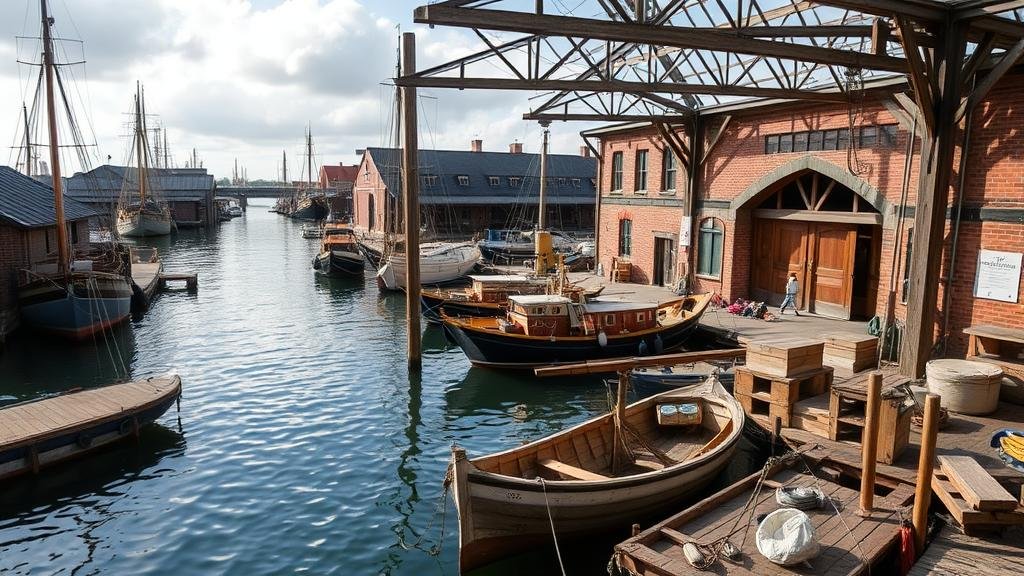Mapping Old Dockyard Warehouses for Nautical Artifact Finds
Mapping Old Dockyard Warehouses for Nautical Artifact Finds
The exploration of maritime history is intricately linked to the analysis and preservation of nautical artifacts. Old dockyard warehouses, often repositories of history, serve as vital locations for archaeological investigations into maritime heritage. This research article examines the methodologies and significance of mapping historical dockyard warehouses for nautical artifact retrieval, highlighting the insights gained from various case studies across the globe.
Historical Context of Dockyard Warehouses
Dockyards have played a critical role in the development of maritime trade and naval power throughout history. Warehouses located within these facilities were designed to store goods, equipment, and ships’ artifacts, providing a unique glimpse into the past. For example, the dockyards of Portsmouth, England, built in the 17th century, are a prime example of such establishments, wherein artifacts related to naval warfare and commerce have been discovered.
Research indicates that between 1700 and 1900, Britain’s naval power expanded significantly, necessitating the construction of extensive dockyards (Morris, 2019). This expansion resulted in many warehouses being built, subsequently becoming important archaeological sites for understanding technological advancements and maritime logistics.
Methodologies for Mapping Old Dockyard Warehouses
The process of mapping old dockyard warehouses involves several methodologies tailored to the specific characteristics of the locations. Geographic Information Systems (GIS) play a vital role in the mapping process, allowing researchers to visualize archaeological features effectively.
- Remote Sensing: This technology includes satellite imagery and aerial photography, which assists in identifying disturbances in the ground that may indicate the presence of buried artifacts.
- Geophysical Surveys: Techniques such as ground-penetrating radar (GPR) and magnetometry provide insights into the sub-surface landscape, making it easier to pinpoint areas of interest.
- LiDAR (Light Detection and Ranging): This method delivers high-resolution maps by utilizing laser light, allowing researchers to detect structural remnants that might not be visible at the surface.
Case Studies: Successful Artifacts Recoveries
Several case studies exemplify the successful application of these mapping methodologies in recovering nautical artifacts from old dockyard warehouses. In Baltimore, Maryland, the Chesapeake Bay Maritime Museum conducted an extensive survey of the former B&O Railroad warehouse, yielding a trove of shipbuilding tools dating back to the 19th century (Williams, 2021).
Similarly, in the docks of Alexandria, Egypt, archaeologists utilized a combination of GPR and traditional excavation techniques to uncover a series of ancient shipwreck sites, alongside personal belongings such as pottery and navigational equipment, enhancing our understanding of ancient trade routes (Ahmed, 2022).
Challenges and Considerations in Restoration and Preservation
The mapping and excavation of old dockyard warehouses are not without challenges. Issues of preservation, funding, and ethical considerations often arise in archaeological undertakings. For example, water levels and climate change can threaten submerged artifacts. As a result, long-term preservation strategies must be implemented to mitigate damage.
- Environmental Factors: The impact of rising sea levels on submerged warehouses can lead to erosion and loss of artifacts.
- Funding and Resources: Many archaeological projects are dependent on grants and donations, which can be inconsistent.
- Ethical Considerations: The excavation and display of artifacts necessitate a respectful consideration of cultural significance and local heritage.
Real-World Applications of Mapping Techniques
The application of mapping these warehouses has broad implications beyond artifact recovery. It can enhance tourism, boost local economies, and educate the public about maritime history. For example, the establishment of the National Maritime Museum in Sydney, Australia, has turned previously mapped dockyard areas into tourist attractions, enriching community engagement with history (Jones, 2020).
Conclusion and Future Directions
Mapping old dockyard warehouses is an invaluable approach to uncovering maritime history through nautical artifacts. Employing advanced methodologies such as GIS and remote sensing not only enhances archaeological practices but also offers insights into the socio-economic dynamics of maritime societies. As maritime archaeology continues to evolve, a multidisciplinary approach involving historians, archaeologists, and technologists will be essential to addressing the challenges faced in protecting and preserving our nautical heritage.
Future research should focus on developing standardized protocols for mapping efforts, promoting collaboration between institutions, and improving public accessibility to maritime history through technology and exhibitions.
References:
- Morris, J. (2019). The Development of Dockyards in Britain, 1700-1900. Maritime History Review.
- Williams, A. (2021). Discoveries at the B&O Railroad Warehouse: A Maritime Archaeology Perspective. Journal of Maritime Archaeology.
- Ahmed, R. (2022). Excavating Alexandria: Ancient Shipwrecks and Trade Routes. Egyptian Journal of Archaeology.
- Jones, M. (2020). The Economic Impact of Maritime Museums: Case Studies in Australia. Journal of Cultural Economics.



